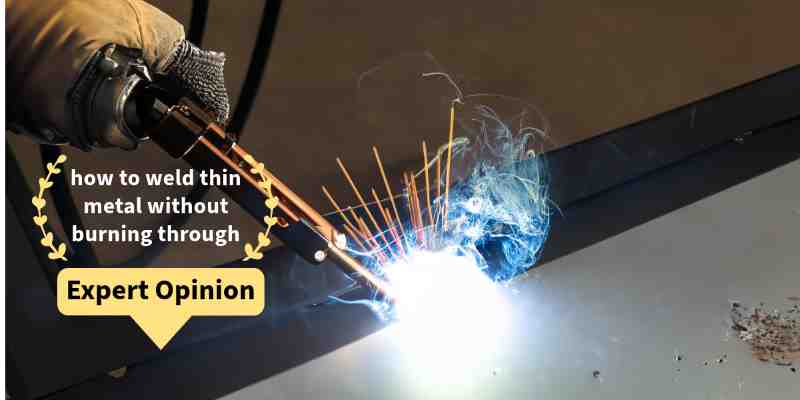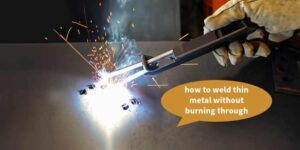Table of Contents
Welding thin metal is a task that demands finesse and precision. The challenge lies in avoiding the dreaded burn-through – the result of excessive heat that melts the metal, creating holes or weak joints. Whether you’re an experienced welder or a beginner, mastering the art of welding thin metal without burning through is essential. This guide provides a step-by-step approach to help you achieve successful results.
Introduction – Weld Thin Metal Without Burning Through
Welding thin metal can be a delicate process, as the risk of burning through the material is a common concern. In this guide, we’ll explore various techniques and tips to help you successfully weld thin metal without compromising its integrity.
Understanding the Challenge
The Sensitivity of Thin Metal Welding
Thin metal, often less than 1/8 inch thick, is prone to heat distortion and warping during welding due to its limited mass. This makes the welding process more challenging, requiring precision and control to prevent burn-through.
Pre-Welding Preparation
Proper Equipment Selection
Choosing the right welding machine and electrode is crucial. Opt for a lower-amperage welding machine and a thinner electrode designed for thin metal welding.
Material Preparation
Clean the metal surface thoroughly to remove any contaminants that could interfere with the welding process. Proper cleaning ensures better adhesion and reduces the risk of burn-through.
Joint Design
Use proper joint designs, such as lap joints or butt joints, to distribute the heat evenly and avoid concentrating it on a single spot.
Techniques for Welding Thin Metal
Tack Welding
Tack weld small points along the joint to temporarily hold the pieces together. This allows you to adjust the alignment and ensure accurate welding.
Stitch Welding
Divide the welding into short segments, allowing each section to cool down before continuing. This technique helps manage heat buildup and minimizes the risk of burning through.
Backstep Welding
Start welding from the endpoint and move backward to distribute heat away from the completed weld. This reduces the chances of overheating the metal.
Pulse Welding
Pulse welding involves alternating between high and low current levels, giving the metal time to cool slightly between pulses. This technique is effective for thin metal as it controls the heat input.
Welding Process
Setting the Right Parameters
Adjust the welding machine settings, such as voltage and wire speed, to lower levels suitable for thin metal. This prevents excessive heat and burn-through.
Welding Speed
Maintain a steady and controlled welding speed to prevent prolonged exposure to heat. A slower pace can help manage the heat input effectively.
Angle and Positioning
Hold the welding gun at a slight angle to focus the heat on the joint and avoid excessive penetration. Adjust the gun’s distance to maintain a consistent arc length.
Post-Welding Considerations
Cooling Period
Allow the welded metal to cool down gradually. Rapid cooling can lead to cracking, while slow cooling helps relieve stress and minimizes the risk of burn-through.
Stress Relief
Perform stress-relieving techniques, such as heat treatment, to eliminate internal stresses caused by welding. This enhances the metal’s durability and reduces the risk of distortion.
Best Welder for Thin Metal
Welding thin metal requires finesse, precision, and the right equipment. The choice of welder plays a pivotal role in achieving strong and clean welds without burning through the material. Whether you’re a professional welder or a hobbyist, selecting the best welder for thin metal can greatly impact your results. In this guide, we’ll explore the key factors to consider when choosing a welder and provide recommendations for some of the top options on the market.
Understanding Thin Metal Welding
Welding thin metal demands meticulous control over heat input to prevent burn-through or warping. A welder with variable settings and precise controls is essential to ensure the right amount of heat for effective welding without compromising the integrity of the material.
Factors to Consider When Choosing a Welder
- Welding Process: TIG (Tungsten Inert Gas) and MIG (Metal Inert Gas) welding are popular choices for thin metal. TIG welding offers finer control over heat and filler material, making it a top pick for delicate work.
- Amperage Range: Look for a welder with a wide amperage range to provide flexibility when working with different thicknesses of thin metal.
- Duty Cycle: A higher duty cycle indicates the welder’s ability to handle continuous welding without overheating. This is crucial for larger projects.
- Portability: If you need to move your welder frequently, consider a portable option that doesn’t compromise performance.
- Ease of Use: User-friendly controls and intuitive settings can significantly enhance your welding experience, especially if you’re a beginner.
- Advanced Features: Some welders come with advanced features like pulse welding, which can be beneficial for achieving precise results on thin metal.
Top Welder Recommendations
- Miller Electric Maxstar 161 STH: This TIG welder offers exceptional control over heat and welding parameters. Its compact design and portability make it a great choice for projects that require mobility.
- Hobart Handler 140 MIG Welder: Known for its ease of use and versatility, this MIG welder is suitable for both beginners and experienced welders. It offers a wide amperage range and adjustable wire speed.
- Lincoln Electric Square Wave TIG 200: If you’re looking for a welder with advanced features, this TIG welder is a solid option. It offers pulse welding technology, making it ideal for intricate work on thin metal.
- ESAB Rebel EMP 215ic: This multiprocess welder combines MIG, TIG, and stick welding capabilities in one machine. Its versatility and advanced features make it a valuable tool for various welding projects.
- Everlast PowerTIG 255EXT: If you’re seeking a high-performance TIG welder, this model is worth considering. It offers a wide amperage range, advanced controls, and excellent arc stability.
Conclusion
Welding thin metal without burning through requires meticulous preparation, proper techniques, and careful execution. By selecting the right equipment, practicing appropriate welding methods, and ensuring thorough post-welding care, you can achieve strong and reliable welds on thin metal surfaces.
FAQs About Weld Thin Metal Without Burning Through
Q1: Can I use the same welding machine for thin metal and thicker materials?
Yes, but you need to adjust the settings and choose suitable electrodes for thin metal to prevent burn-through.
Q2: Is it necessary to clean the metal before welding?
Absolutely. Clean metal ensures proper adhesion and reduces the risk of contaminants affecting the weld quality.
Q3: What’s the advantage of pulse welding?
Pulse welding helps manage heat input, making it ideal for thin metal welding, where heat control is crucial.
Q4: How can I prevent warping in thin metal during welding?
Proper joint design, controlled welding speed, and gradual cooling all contribute to reducing the risk of warping.
Q5: Is stress relief necessary for all welded thin metal pieces?
Stress relief is recommended, especially for critical applications, as it enhances the metal’s stability and longevity.


1 thought on “How to Weld Thin Metal Without Burning Through”